The Volunteers and Vehicles That Come to the Rescue in Moab
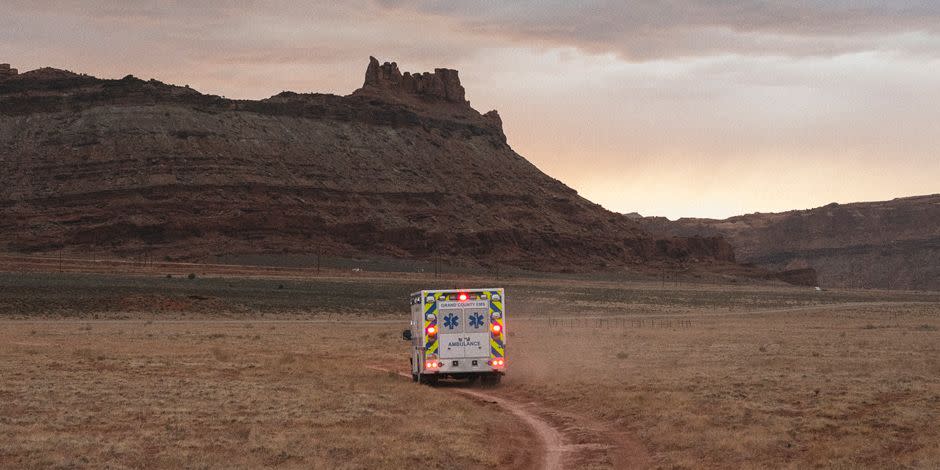
There was a group of mountain bikers. Their GPS battery died, leaving them stranded, after dark, with no lights. They didn’t pack lights, because they didn’t plan to be out past dark, because they didn’t plan to get lost, because they had GPS. Another time, a family went missing for days. The helicopter couldn’t spot them. John Marshall, who’s been volunteering with Utah’s Grand County Search and Rescue (GCSAR) since 2004, grabbed a buddy and some dirt bikes and tracked them down. Their rental Jeep was stuck in sand, still in two-wheel drive. “The equipment can’t help you if you don’t know how to use it,” Marshall told me. “It’s not just renters,” added another GCSAR volunteer, Nadi Ardalan. “People don’t know what they own. I went out the other day for a guy in an F-350. Asked him if the hubs were locked. He said, ‘What are hubs?’”
This story originally appeared in Volume 6 of Road & Track.
SIGN UP FOR THE TRACK CLUB BY R&T FOR MORE EXCLUSIVE STORIES
I laughed, but not for long. “A lot of people don’t know how to get their own coordinates. They are on your phone!” Marshall said. “In the compass app, or you can ask Siri.” My phone was dead; I’d forgotten to charge it, so I just nodded. Then I stepped out of the Argo and instantly sank up to my knees in snow. Everyone—even the Argo, an amphibious tracked ATV that could have been styled by Jim Henson—looked at me with the pressed-lip countenance of a stifled laugh.
What’s to be done with city fools and weekend adventurers who come to Utah with a longing for solitude but less bushwhacking experience than a rooftop gardener? I could see myself in any one of the situations neatly written on the whiteboard at GCSAR headquarters. Ledged out: climbed up, can’t climb down. Darked out: didn’t bring lights, sun went down. Tripped, fell, turned around, turned over. Stuck in water, sand, snow. Not back by scheduled time. Who saves us when we venture beyond the limits of our supplies, skills, and suspensions, and why do they bother?
“Oh, definitely for the money.” Seamus Hannigan made everyone laugh with that. The GCSAR team is all volunteer. They get a small hourly stipend for answering calls, but those calls generally take them away from their day jobs, or out of bed at midnight. The gig’s not making anyone rich. When they quit joking, every member landed on a similar answer: Because it’s nice to be part of a team. And for many of them, it’s personal. “Nadi once rescued my wife’s cousin,” said Hannigan. “He was stuck on a ledge like a cat in a tree,” said Ardalan.
Ardalan himself first encountered GCSAR from the receiving end, and he’s not the only one on the team who learned about search and rescue from the viewpoint of, as he puts it, “a client.” A decade ago, he’d gone on a short hike that turned into an overnight. His wife called the sheriff. While GCSAR was preparing the search dogs, Ardalan made it to a main road, met some other hikers, and borrowed a phone. “My wife said, ‘The whole world is looking for you! There’s a helicopter on its way!’” A ranger gave him a ride back to his truck, where he sheepishly introduced himself to the team preparing to look for him. Their kindness left an impression. He started training a few months later.
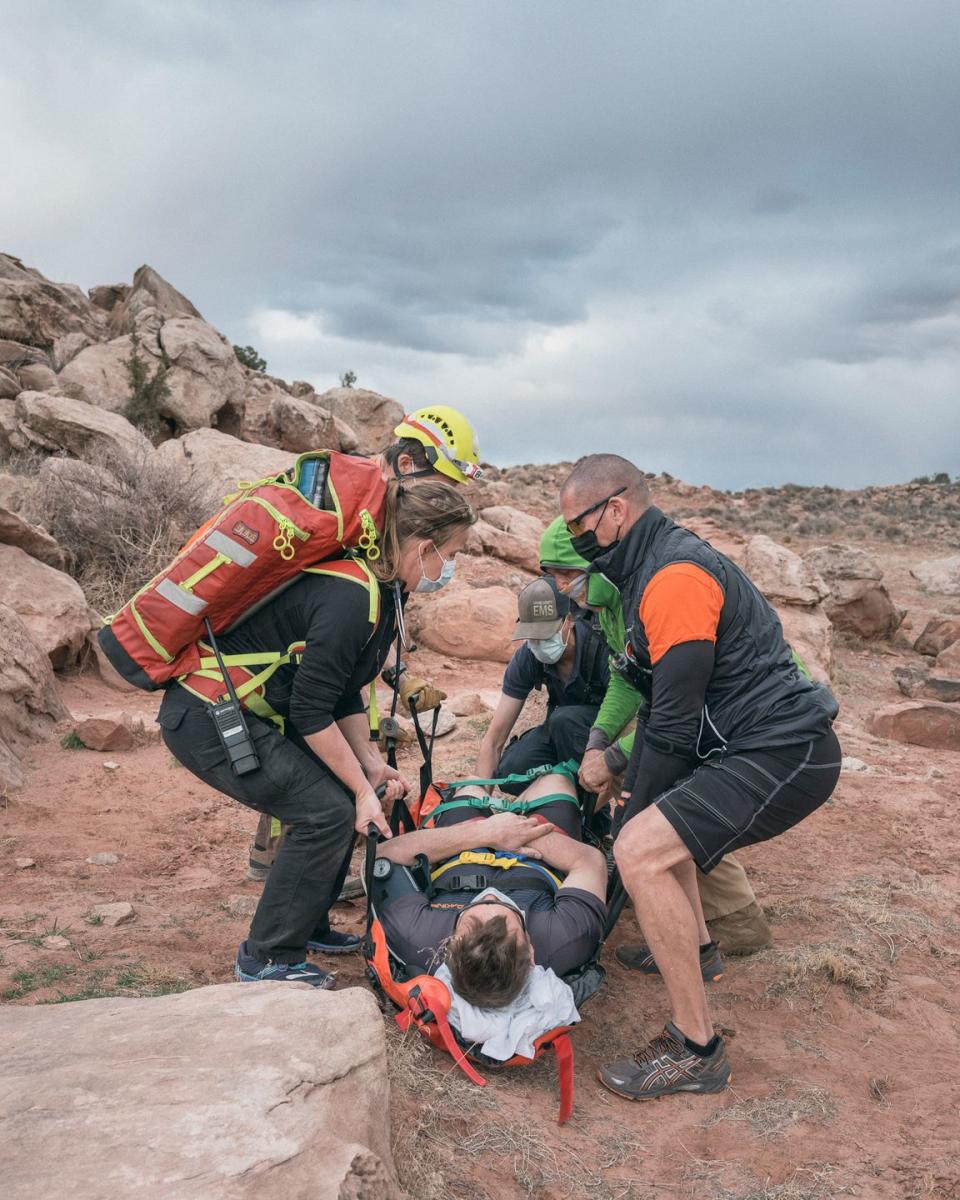
GCSAR is the busiest search-and-rescue team in Utah, performing some of the most varied and complex missions in the country: river rescues to night climbs, 100-degree canyons to snow-covered passes, sometimes in the same weekend. GCSAR averages 130 calls a year; they help out the Arches and Canyonland teams, too, so call it 300 total. Their members have every kind of backcountry skill set, plus a garage full of gear to handle an alphabet of accidents, from avalanches to zipline mishaps. Ardalan and Marshall aren’t just EMTs and wilderness guides, they’re also mechanics. Marshall off-road races a G-Wagen, and Ardalan started his four-wheeling career as a Land Rover specialist. They handle most of the outfit’s transportation needs, which is why, in addition to the usual hand-me-down sheriff’s department pickups, GCSAR has customized ATVs, boats, the adorable Argos, even a hovercraft. Ardalan thinks it will be useful for low-water rescues, but also, he really wanted a hovercraft. (GCSAR’s wacky rides are privately owned, loaned to the team as needed.)
Moab has exploded. A busy weekend doubles the 5000-person town. Crowds make it more likely that a turned-around traveler will find a helpful soul before they wander into trouble. Still, you can veer off any major road and be out of sight and cell signal in under an hour. Between the two national parks and the open land surrounding them, there are 4000 square miles in which to choose the wrong adventure.
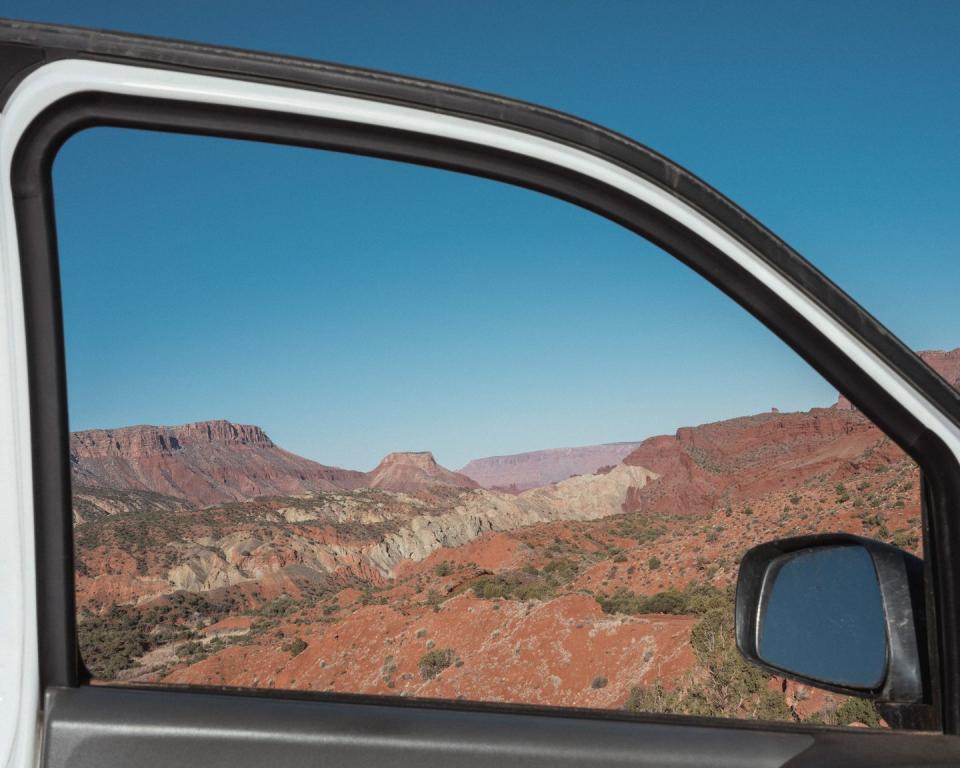
“Wilderness is 15 minutes from here,” said Ardalan. We were standing behind the white metal warehouse on the outskirts of Moab that serves as GCSAR headquarters, ducking the dust from a helicopter painted the same deep red as the cliffs. The helo was on a medical call, no need for search and rescue, but we watched it rise until it was a speck in the denim-blue sky, then a second longer, and it was gone.
Despite regularly observing them, Ardalan can’t draw a helicopter. I know this because he made a hash of it trying to illustrate the importance of rotor size when you’re trying to load a patient in a sling on the edge of a steep gravel scree next to a thousand-foot sandstone cliff. “If she’d been closer to the cliff face,” he said, “we would have had to bring her down the slope. That would have been a challenge.” It was a night rescue in February that took hours and required two helicopters; the little medical copter couldn’t land safely at the scene, so crews had to call in a second, airlift-capable bird. A white-knuckle scenario, but it’s all in a day’s—or more often, a night’s—work for GCSAR.
When GCSAR commander Jim Webster agreed to let me spend a weekend with the team, I figured I’d hear mocking stories about silly city folk like me who read one Edward Abbey book and get themselves wedged in a rock formation. But that’s not how anyone here thinks about rescues. “Things happen,” Erinn Looney-Triggs, a former park ranger, told me. “Bad luck, mistakes, misunderstandings. I’ve done ’em all, so I’m not going to judge someone for them.” He paused to look up at the cliffs. Anywhere you are in Moab, even at the top of a cliff, you can look up at more cliffs. The place is like a staircase for giants. “Maybe I haven’t done ’em all at once. But I’ve been lost. I’ve felt that panic.”
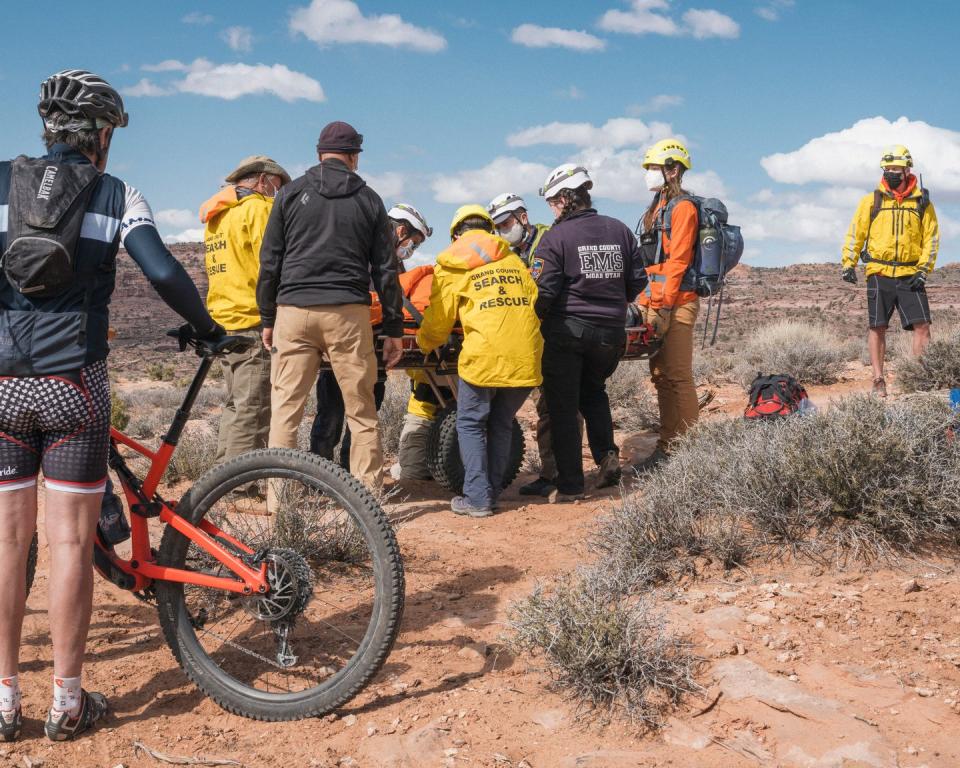
Sometimes getting folks out is as easy as bringing a ladder and some moral support. Other times it requires driving a Polaris Ranger ATV down trails barely wide enough for a mountain bike, or trundling 10 miles through snow in a 5-mph Argo. Occasionally, rescue involves throwing a rope over the side of a mountain and shimmying down, or dropping from a helicopter. Ardalan once spent all night building a rappelling-friendly dog kennel to rescue a border collie who fell off a cliff. “Dogs are like people,” he tells me. “Not that intelligent about edges.” There’s an unmaintained road from Gateway, Colorado, that some GPS systems show as an easy shortcut. Already this year, the team has saved three drivers stuck in the pass. “Generally,” Ardalan offered, “if the snow is deep and you’re still going up, it’s going to get deeper.”
I visited GCSAR in March. It’s a busy time of year. The incident board was already filled up with motorcycle accidents, folks stuck on ledges, the climber’s fall that Ardalan had drawn for me, and an “overdue subject”—search-and-rescue talk for a lost hiker. That person was found unharmed, but while searching, the team found a different guy who got his SUV stuck in a ditch with no way to call for help and nobody who knew where he’d gone.
“Sometimes we just get lucky,” said Ardalan.
“Sounds like he was the one who got lucky,” photographer Trent Bailey offered.
It was late afternoon when we got our first call of the weekend. The radio crackled with static, then with coordinates, two calls coming in simultaneously. One was a medical matter that didn’t require search and rescue; the other was a mountain bike accident with a leg injury near Bar M Trail, on the other side of town.
The biker crashed right where the hills open up into a wide meadow. The scene’s lonely beauty probably wasn’t top of mind for the man being swaddled in a rescue mat and lifted gently onto the wheeled litter. Evacuating a patient over uneven terrain calls for a lightweight but sturdy stretcher, a titanium contraption that looks like a race car’s roll cage flattened into a camping cot.
The biker was apologizing to the EMTs and joking with his son, a flustered teen in fluorescent sunglasses. The biggest concern seemed to be what to do with the bikes, a problem so common in Moab that most ambulances have a bike rack on the side.
As the ambulance doors clicked shut, it started raining, big drops that thudded on the ground. Nothing in the forecast had mentioned rain, and a few hills over, the sun was setting in a cloudless golden shawl. It was easy to see how a few minutes or miles could turn a walk in the park into a line on the incident board.
Next day, another call. A cyclist again, this one far down a steeper trail with a more serious break. The SAR crew drove the Rangers as far as they could, then hiked the rest. No jokes from this client; he was clearly in pain. As the crew lifted him onto the litter, he said lightly, “I knew it was coming, but I still enjoyed it.”
The EMT raised an eyebrow. “Those narcotics kicking in?”
“Oh yeah,” he answered. Then he was on the litter, and the unwieldy rescue centipede tried not to jostle him or step too far off the trail as they followed the cliff’s edge back to the ATVs.
There’s some longing in all of us to be where others are not. To find those places, we hike and bike, rent buggies and Jeeps, float out in canoes, dangle on ropes. Sometimes we push equipment beyond its engineering, forget some necessity, or fail to download the map. There are so many ways to leave the path. What comfort, then, to know there are people willing to drop their plans, bail on dinner, and spend the night retracing our steps until they find where we took the wrong one.
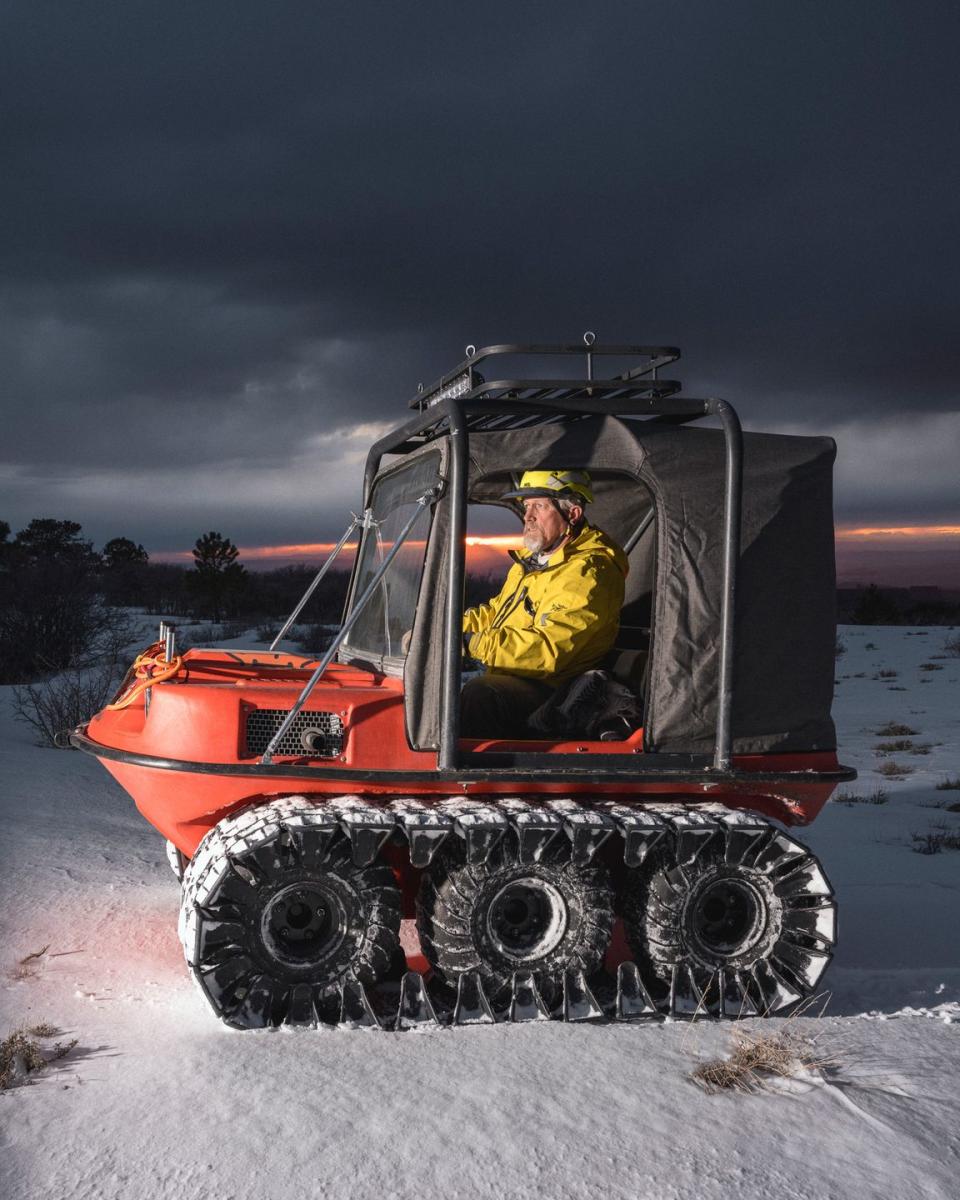
The Argonauts
It looks like the offspring of a bathtub and a tank, and it’s been cruising over challenging terrain since 1967. It’s the Argo, built by Ontario Drive and Gear. ODG started out making gearboxes for amphibious recreational vehicles; soon, the company made its own, the Argo. While skid-steer ATVs were largely abandoned for motorcycles and three- and four-wheelers, ODG stuck with its little plastic-hulled boat-tank, upgrading and evolving the design. Today’s Argo is a reliable choice for bomb squads, search-and-rescue outfits, and outdoor adventurers. An Argo even served as a prototype for the Canadian Space Agency’s lunar rover.
SIGN UP FOR THE TRACK CLUB BY R&T FOR MORE EXCLUSIVE STORIES
You Might Also Like

 Yahoo Autos
Yahoo Autos 